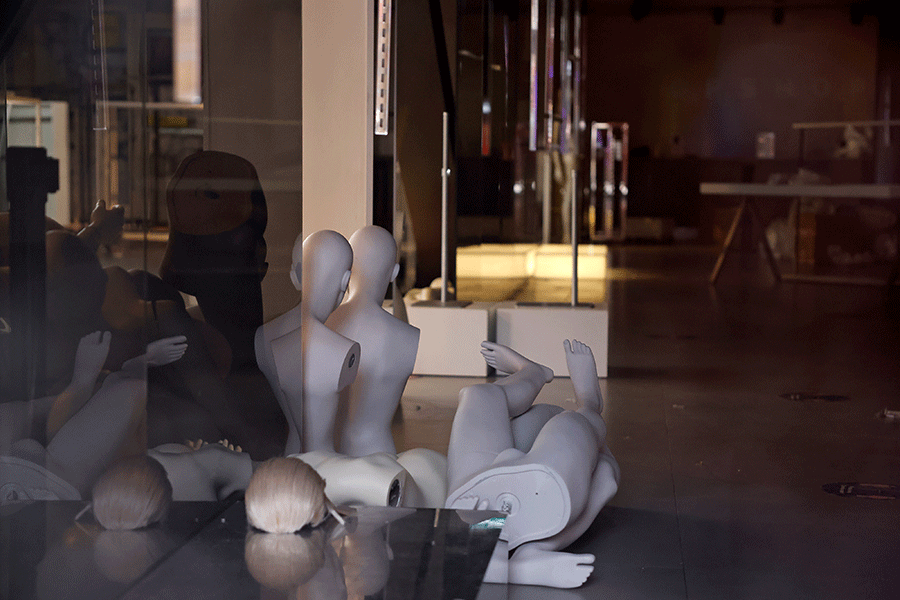It was the last days of The Face (1980–2004) and I had just turned 18. London was drawing me in from the provinces, another teenage twink for whom the city had become a quivering, explosive symbol of escaping towards the future. I could probably count the number of times I’d visited on one hand: a few times as a child, to see my uncle and visit Hamleys toy shop; twice as a teenager, on a trip with a youth group for miscreant adolescents; and as one of the last trips I took with my mum before she became too sick to travel. And now, for the first time, I was visiting alone, there to meet my boyfriend, another small-town gayboy from the Welsh Valleys who I’d met online and fallen in love with. He had spent the first instalment of his student loan on a tiny and disgusting single room in a Piccadilly hotel, not that we cared, or slept; we went to a punk show, to Tate Modern, to Camden Market. And then we went to Topshop, because Topshop was made for us.

Top Shop, 2021. Courtesy: Getty Images; photograph: Tolga Akmen / AFP
It’s easy to look back on the store with cynical eyes given that, in retrospect, I was more like a teen-consumer droid just waiting to have my disposable income drained at the checkout thanks to perfectly pitched, cheaply made garments designed to hit the sweet spot between ‘feeling cool and on-trend’ and ‘comfortable enough to wear in suburban high streets and provincial nightclubs’. But Topshop’s flagship store on Oxford Street was also part of a thrilling entry into a consumer culture still based around the physical shop, where not just the mannequins and racks but also the other customers were part of a choreographed stage for watching, learning, appreciating and desiring. Perhaps I was only buying a striped black and white T-shirt with a faux sailor tattoo print on it, or a plain white shirt with a skinny black tie. (It was the early 2000s and I was torn between emulating the Yeah Yeah Yeahs’ New York, art-punk cynical cool and Patrick Wolf’s winsome, neo-folk, Ruritanian Little Lord Fauntleroy earnestness: luckily, Topshop had something for either look within my price range.) But what I thought I wanted was complicated by seeing so many other teenagers attempting new things around me, and the opportunities they seemed to manifest in the streets outside. To me, everyone in that Topshop was buying a new outfit for G-A-Y Late that very night (the greatest night ever, which I wouldn’t be attending) or was going to a party with their impossibly desirable colleagues from art school (who I would never be friends with). But here I could learn and try and hope – and, one day, realize myself in these off-the-rack garments. It is true that Topshop’s business model cannibalized youth culture, churning out a limited range of styles carefully calibrated for decades to produce a lowest common denominator product that turned the latest, often-working-class, fashions and marketed them back to us. Yet, it can also be true that, within that process, so many young people took their first tentative chances experimenting with their own identity – purposefully alienating themselves from their parents, siblings and peers – and began, for the first time, to feel a sense of adult autonomy by choosing to dress themselves. Topshop’s Oxford Street flagship was a machine for producing teenagers: a churning factory of desires and hopes and sweating, aching failure.

Top Shop, 2021. Courtesy: Getty Images; photograph: Tolga Akmen / AFP
On one side of this process lay the exploitation of workers through the cheap supply lines of fast fashion and, on the other, the pension-fund deficits, tax avoidance and political patronage that became the popular legacy of Topshop’s owners since 2002, the Green family; as a whole, it became an environmentally, economically and culturally unsustainable process, whose collapse was inevitable. Ultimately, what changed was the teenagers themselves: their agency and their eye for their own image and identity was absolutely revolutionized by the power of smartphones and Tumblr and Depop and TikTok. The urban shopping experience is changing, too; the flagship stores no longer feel like sites of great and bustling commerce, Benjaminian arcades of import and export luxury for the masses, of piled-up goods perpetually restocked. Instead, sometimes, walking down Europe’s major shopping boulevards – Oxford Street, Paris’s Champs-Élysées, Passeig de Gràcia in Barcelona – I feel more like I’m walking through the shops of an airport departure lounge. I can’t believe that the store profits can possibly justify the relentlessly rising cost of real estate; or, if they do, the ratio must be greatly diminished. Without the presence of these brick-and-mortar shops, however, it feels like brands might just fade away. They must be seen to exist as shopping opportunities – the presence of the flagship store a real-world avatar of the actually real online shopping experience. Perhaps I’m wrong, and a few high-rolling spenders or out-of-towners continue to make these outlets viable but, if so, the sense of collapse is still real: it just doesn’t feel like this is where shopping happens anymore. I don’t think it’s simply my own ageing that made Topshop seem like the most prominent example of this; compared to the explosion of teenage creativity online, visiting Topshop began to feel increasingly like watching a brand desperate to catch up and – as my own youthful experience proved – desperation is toxic to the teenager. It was inevitable that the first, fastest, most youthful flagship would be the first to be caught up in the tempest and dashed upon the rocks.
This article first appeared in frieze issue 222 with the headline ‘What Was Topshop’
Main image: Top Shop, 2021. Courtesy: Getty Images; photograph: Tolga Akmen / AFP














Pentru a putea adăuga comentarii trebuie să fii membru al altmarius !
Alătură-te reţelei altmarius